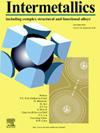Ti对TixVNbMo (x=0.5, 1.0, 1.5, 2.0)耐火高熵合金组织和力学性能的影响:原理与实验相结合的研究
IF 4.3
2区 材料科学
Q2 CHEMISTRY, PHYSICAL
引用次数: 0
摘要
采用实验和理论计算相结合的方法,系统研究了Ti含量对TixVNbMo (x = 0.5, 1.0, 1.5, 2.0)耐火高熵合金(RHEAs)相组成、显微组织和力学性能的影响。TixVNbMo RHEAs均为BCC单相固溶体结构,且晶格常数随Ti含量的增加而增大。通过生成焓、内聚能和声子谱的分析,证实了其热力学和动力学稳定性。随着Ti含量的增加,合金的硬度、屈服强度和弹性模量逐渐降低,呈现各向异性。Ti2.0合金塑性最好,Ti0.5合金比屈服强度最高。TixVNbMo RHEAs的强化机制主要是固溶体强化。用COHP分析了TixVNbMo RHEAs的电子结构,结果表明,Ti含量越高,内部结合力越弱,导致抗压强度降低。总的来说,本研究从多个尺度上深入了解了TixVNbMo RHEAs的微观结构和力学行为,这对其潜在的应用至关重要。本文章由计算机程序翻译,如有差异,请以英文原文为准。
Effect of Ti on the structure and mechanical properties of TixVNbMo (x=0.5, 1.0, 1.5, 2.0) refractory high-entropy alloys: A combined first principles and experimental study
The effect of Ti content on the TixVNbMo (x = 0.5, 1.0, 1.5, 2.0) refractory high-entropy alloys (RHEAs) was systematically studied by combining experimental and theoretical calculations, focusing on phase composition, microstructure and mechanical properties. All the TixVNbMo RHEAs have a BCC single-phase solid solution structure, and the lattice constant increases with the increase of Ti content. Thermodynamic and kinetic stability are confirmed through analyses of enthalpy of formation, cohesive energy, and phonon spectrum. With the increase of Ti content, the hardness, yield strength and elastic modulus gradually decrease, and all alloys are anisotropic. Ti2.0 alloy exhibits the best plasticity, while Ti0.5 alloy has the highest specific yield strength. The main strengthening mechanism of TixVNbMo RHEAs is solid solution strengthening. The electronic structure of TixVNbMo RHEAs was analyzed by COHP, and the results showed that the higher the Ti content, the weaker the internal bonding force, which leads to a decrease in compressive strength. Overall, this study provides insights into the microstructure and mechanical behavior of the TixVNbMo RHEAs from multiple scales, which is crucial for their potential applications.
求助全文
通过发布文献求助,成功后即可免费获取论文全文。
去求助
来源期刊

Intermetallics
工程技术-材料科学:综合
CiteScore
7.80
自引率
9.10%
发文量
291
审稿时长
37 days
期刊介绍:
This journal is a platform for publishing innovative research and overviews for advancing our understanding of the structure, property, and functionality of complex metallic alloys, including intermetallics, metallic glasses, and high entropy alloys.
The journal reports the science and engineering of metallic materials in the following aspects:
Theories and experiments which address the relationship between property and structure in all length scales.
Physical modeling and numerical simulations which provide a comprehensive understanding of experimental observations.
Stimulated methodologies to characterize the structure and chemistry of materials that correlate the properties.
Technological applications resulting from the understanding of property-structure relationship in materials.
Novel and cutting-edge results warranting rapid communication.
The journal also publishes special issues on selected topics and overviews by invitation only.
 求助内容:
求助内容: 应助结果提醒方式:
应助结果提醒方式:


